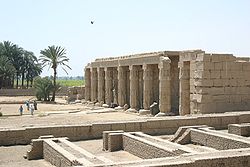Kurna
Kurna | |
|---|---|
UTC+2 (EST) | |
| • Summer (DST) | +3 |
Kurna (also Gourna, Gurna, Qurna, Qurnah or Qurneh;
New Qurna was designed and built in the late 1940s and early 1950s by Egyptian architect
Historical use of the name Qurna
The name Kurna signifies "a promontory" or "a point of a mountain".[1]
Émile Amélineau identifies it with ancient Pekolol (Coptic: ⲡⲕⲟⲗⲟⲗ).[2] The name Gourna is first mentioned by Protais and Charles François d'Orléans, two Capuchin missionary brothers travelling in Upper Egypt in 1668. Protais’ writing about their travel was published by Melchisédech Thévenot (Relations de divers voyages curieux, 1670s-1696 editions) and Johann Michael Vansleb (The Present State of Egypt, 1678).
References to Qurna, Gurna, Kournou, Gourna, El-Ckoor’neh, Gourne, el Abouab, El-Goor’neh or many other variants in pre-1940s literature refers to a spread out
During the 18th, 19th and 20th centuries, visitors and travelers to the area are rarely consistent in their use of the name and anything between
A reference to the "Temple of Gourna" or similar, is in most cases a reference to the Ramesseum, to a lesser degree the Temple of Seti I and rarely it is a reference to the all but destroyed Mortuary temples of Ramesses IV, Thutmose III or Thutmose IV.
The villages


New Qurna (or New Gourna)



New Qurna downside
Many of the buildings that were built had foundations of salt stones. Due to the high humidity, the salt stones would dissolve, causing the structure of the houses to fail. Villagers would need to adjust and fix their homes every few months in order for the house to remain intact. [5]
Qurna (or Old Gourna)

Qurna is an abandoned village about 100m to the east of the Temple of Seti I. Until the early 19th century the community included at least parts of the Temple of Seti I. Several travellers, including Richard Pococke or Sonnini de Manoncourt even name a Sheikh of Qurna.[8][9] Edward William Lane relates in 1825 that the village was abandoned and not a single inhabitant lived there. Comments by Isabella Frances Romer[10] suggests that the resettling started in the late 1840s. Hassan Fathy alleges that the inhabitants of Qurna lived in poverty and thus were robbing ancient tombs as means of subsistence. Families of the villagers settled down on top of the selected tombs where they would build their houses. Villagers built alongside the tombs, as the tombs became a part of the house. Looted items would either be sold, or kept around the homes of the villagers.[11] In order to stop the looting the Department of Antiquities expropriated the land on which the Qurnis lived and decided to move them to a new settlement, to be designed and built by Hassan Fathy himself.[12] No two houses in the village are the same. Kurnis built and shaped the houses and all of the furniture within; including any kind of chairs, tables, beds.[4] New Qurna was built in the 1940s and early 1950 to house the then residents who strongly resisted the move.
Sheikh Abd el-Qurna
A series of housing built in and around the mountain grottoes located about 200m north of the Ramesseum at
Restoration at New Gourna
See also
- List of ancient Egyptian sites, including sites of temples
References
- ^ Edward William Lane, Description of Egypt - notes and views made during the years 1825-1828, The American University in Cairo Press, 2000
- ^ Amélineau, Émile (1893). La géographie de l'Égypte à l'époque copte. pp. 358.
- ^ "Archnet". www.archnet.org. Retrieved 2021-12-16.
- ^ ISSN 1878-0296.
- ^ a b "New Gourna Village". World Monuments Fund. Retrieved 2021-12-16.
- ^ "UNESCO launches safeguarding project at New Gourna Village, part of Ancient Thebes World Heritage site".
- ^ "New Gourna Village". World Monuments Fund. Retrieved 2018-02-26.
- ^ Richard Pococke, A Description of the East and Some other Countries, Vol.I: Observations on Egypt, W. Boyer, London, 1743
- VII(1798) 4 vol.
- ^ Isabella Frances Romer, A Pilgrimage to the Temples and Tombs of Egypt, Nubia, and Palestine in 1845-46, Richard Bentley, London, 1846 2 vol.
- ISSN 1877-0428.
- ^ Hassan Fathy, Architecture for the Poor, The University of Chicago Press, Chicago and London 1973, p.14ff
